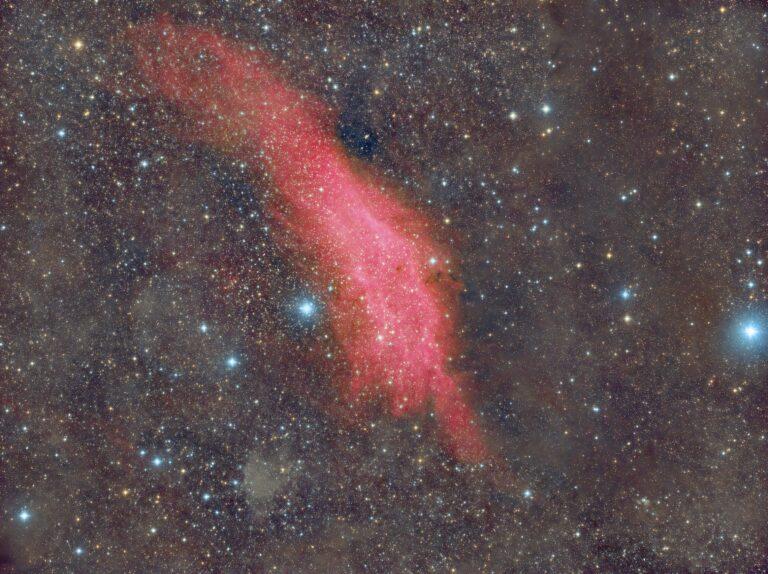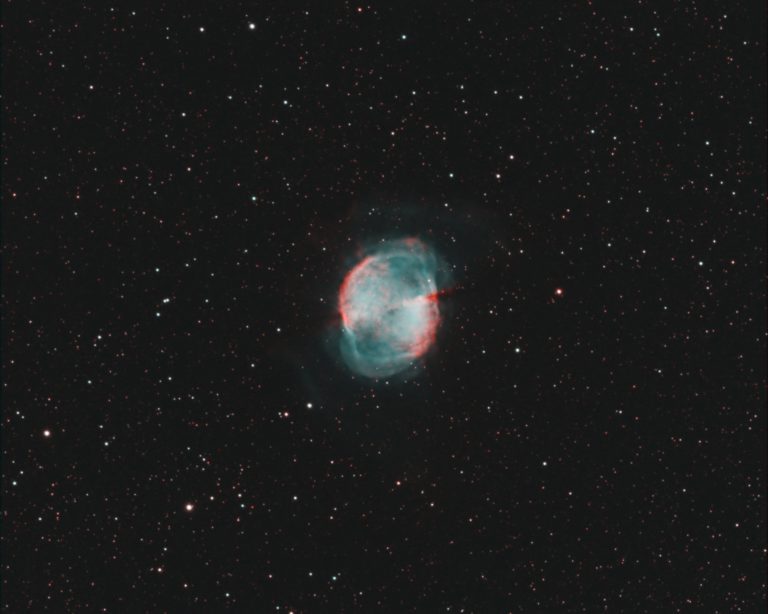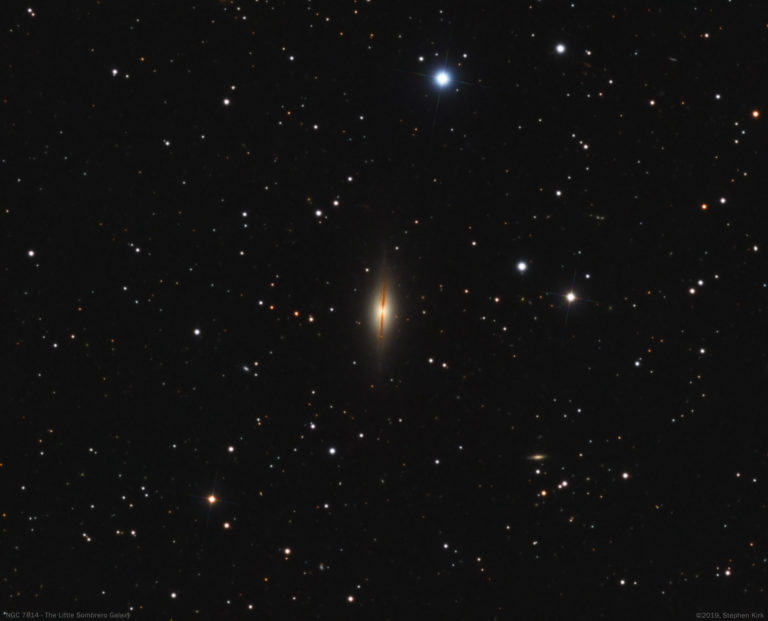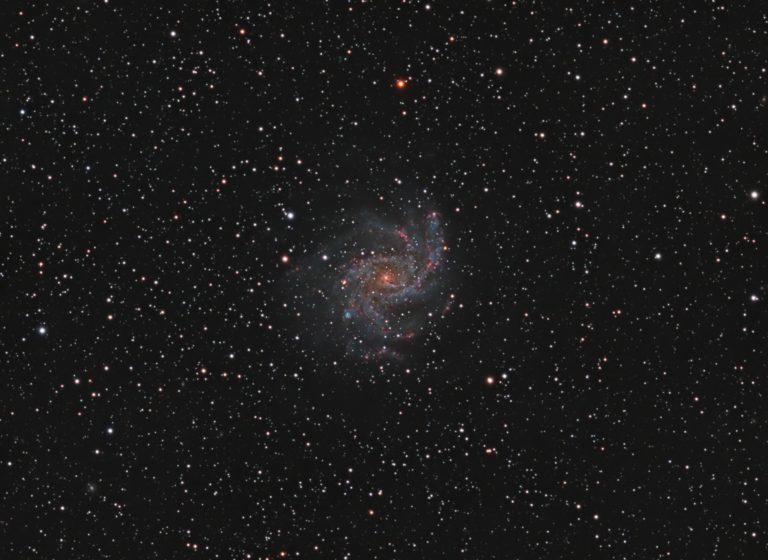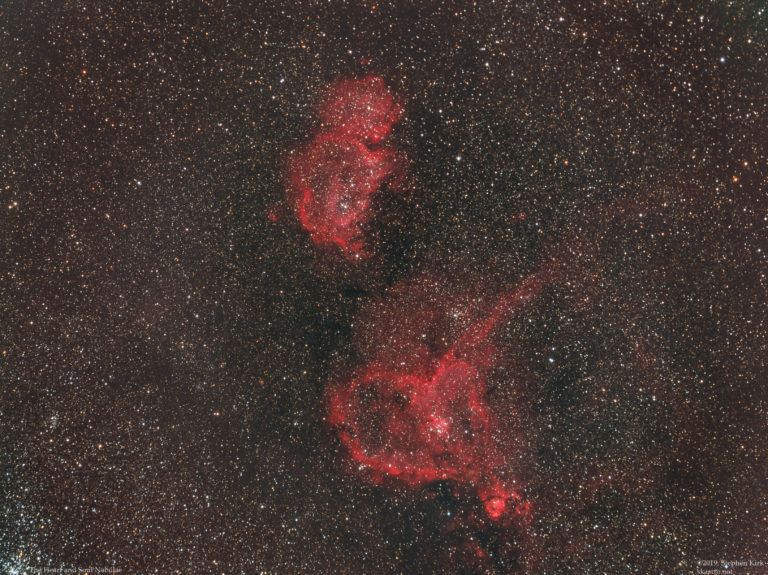The California Nebula – NGC 1499 – is a vast hydrogen gas emission nebula about 1000 light years away in the constellation of Perseus. It is named as such because of its vague resemblance to the US state of California.It is a very large, faint and diffuse object, about four times the diameter of the moon. It is almost completely invisible visually without specialist filters and was not discovered until the advent of astrophotography in 1884. The nebula shines by reflecting the light of the bright star Markib. It shines red because Hydrogen atoms, when excited by nearby bright sources like stars, emit or re-radiate light at the 656nm wavelength which is in the red part of the spectrum to our eyes. The California Nebula Image Technical Data The California Nebula is so large that most telescopes cannot get the nebula in the field of view, nowhere near in fact. …
M27 is a famous planetary nebula in the constellation of Vulpecula, The Fox. Despite its name, it has nothing whatever to do with planets, it is instead the remnants of a dying star that has cast off its outer atmosphere when nuclear reaction can no longer sustain it. Our Sun will look like this in five billion years from afar. M27 is a fine object to view through a telescope. I have also imaged M27 several times over the years. Here for example. The rendition on this page shows M27 in the HOO or Hydrogen-Oxygen-Oxygen palette which maps the Ha channel to Red and green and Blue to OIII (Oxygen 3). Planetary nebula are rich in Oxygen since it is one of the elements synthesised in the nuclear fusion processes as the star dies. M27 – The Dumbbell Nebula in Vulpecula Image Technical Data Imaged from my backyard observatory in…
NGC 7814 – The Little Sombrero Galaxy NGC 7814 is an edge-on spiral galaxy 40 million light-years away in the constellation of Pegasus. IT is nicknamed “The Little Sombrero” because of its likeness to The Sombrero Galaxy M104 in Virgo. Close examination of the picture reveals many tiny galaxies, up to a billion light years away in the depths of The Universe.The dust lanes of the edge-on spiral arms can be easily seen. Image Technical Data NGC 7814 is very remote and so needs a long integration (exposure) time. This image was captured from my backyard observatory in Nottingham, UK over the course of three nights in October 2019 (a very wet period in the UK and the capture nights were 2,17 and 24). It took significant dedication to capture the subframes for this image given the dreary weather circumstances and I nearly gave up on several occasions! I used…
NGC6946 – The Fireworks Galaxy NGC6946 is located on the border between Cygnus and Cepheus and is a fairly bright galaxy about 25 million light years away. It is dubbed the “The Fireworks Galaxy” due to the unusually high number of supernovae that have occured here – ten – that have been observed during the last century. Typically a galaxy would normally have one per century and it is not known why this galaxy has had ten times the average. The galaxy is quite heavily obscured by dust within our own galaxy and this is probably the reason why it was not accorded the honour of a Messier catalogue number. Image Technical Details Imaged from my back yard in Nottingham, UK, during September 2020 whilst high overhead. I used my TEC140 refractor with Atik 460 CCD camera and Astrodon LRGB Generation 2 E series filters and a Ha (3nm) filter. …
The Heart and Soul Nebulae are a well known and famous pairing of Nebulae in the late summer/autumn sky of the Northern Hemisphere. These nebulae are located far away – 7500 light years – in the Perseus arm of the galaxy, further out from the core of the galaxy than the Sun and are vast star forming regions rich in Hydrogen Alpha that gives the images the intense red glow.All image data collected with a Samyang 135mm lens at F2.8 with a Moravian G2-8300 CCD camera. Below is the RGB image gathered with Astrodon RGB filters. All binned 1×1: Red 14 x 300s; Green 13 x 300s; Blue 14 x 300s. This gives an RGB integration time of 210 minutes or three and a half hours.The picture looks nice but it does lack punch and vibrancy as it stands. It needs the addition of the Hydrogen Alpha data that will…

